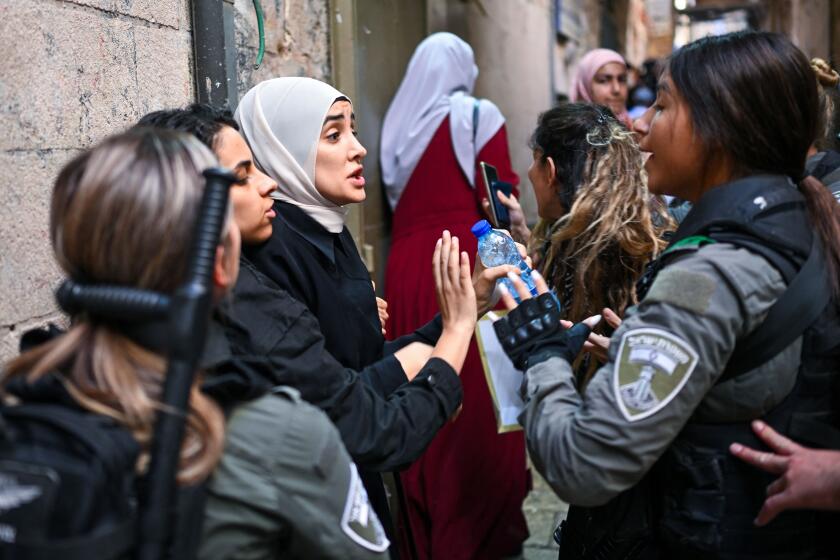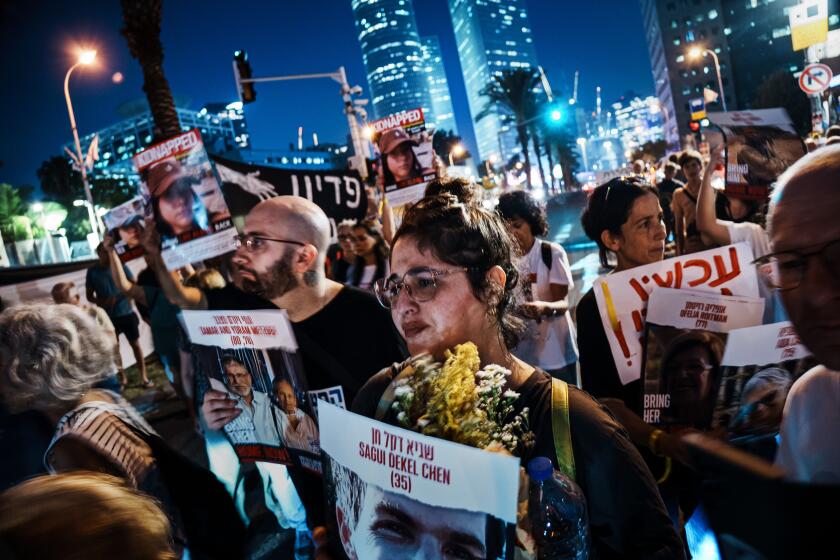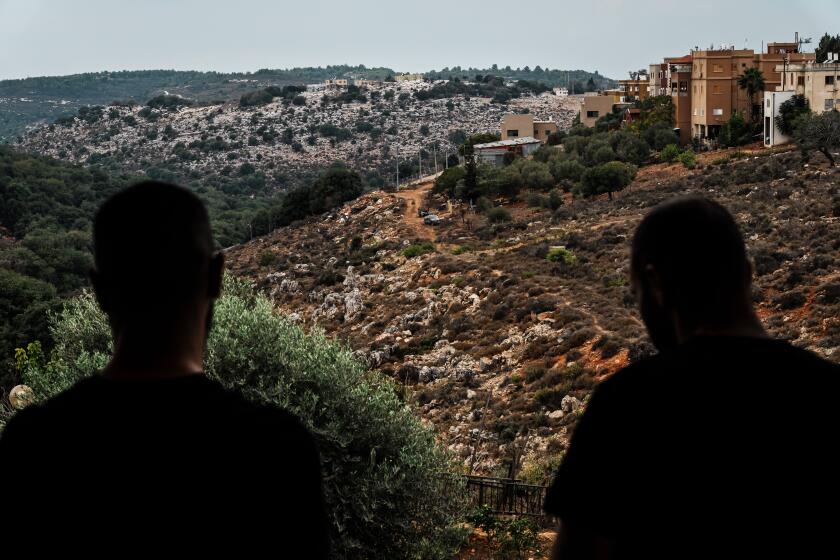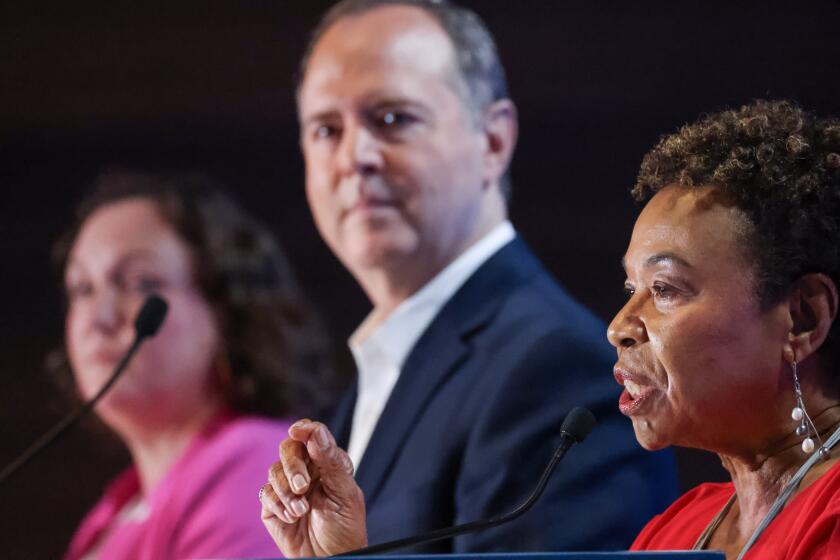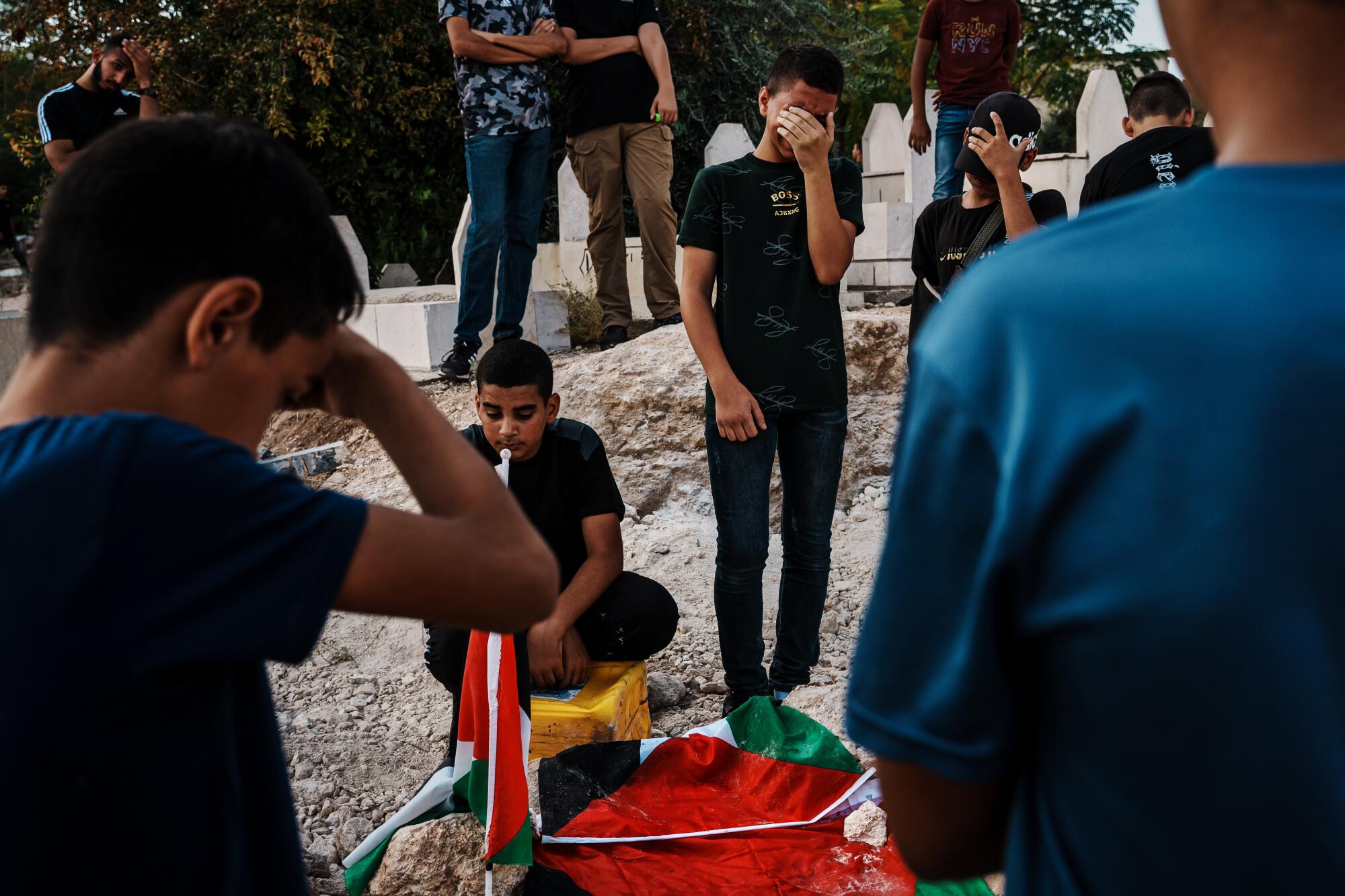
- Share via
TULKAREM, West Bank — The funeral started loudly, with dozens of automatic rifles firing into the air and men chanting as they carried the body of 15-year-old Ali Khazneh, wrapped in Palestinian flags, from the mosque to the cemetery crowded with mourners.
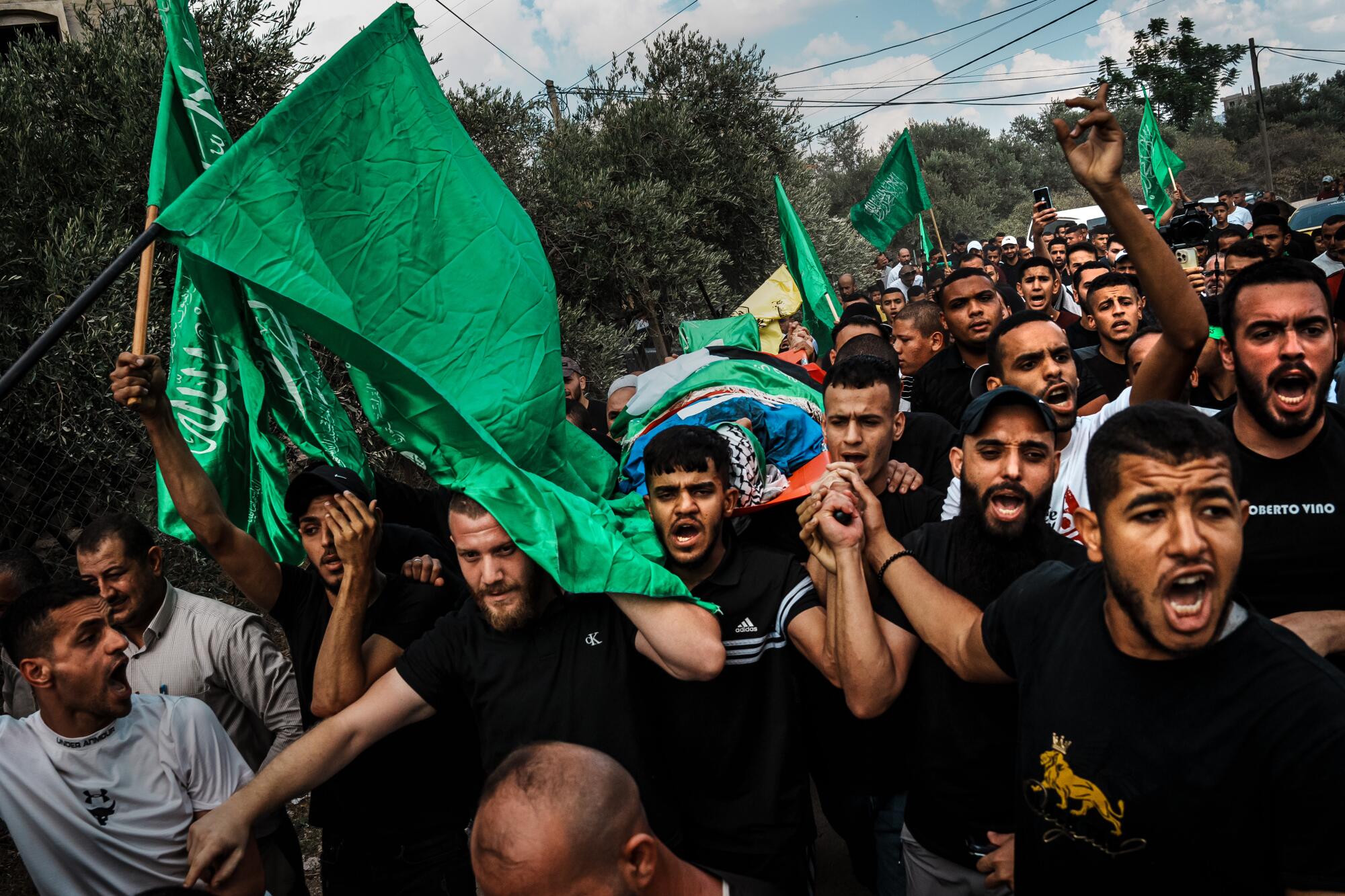
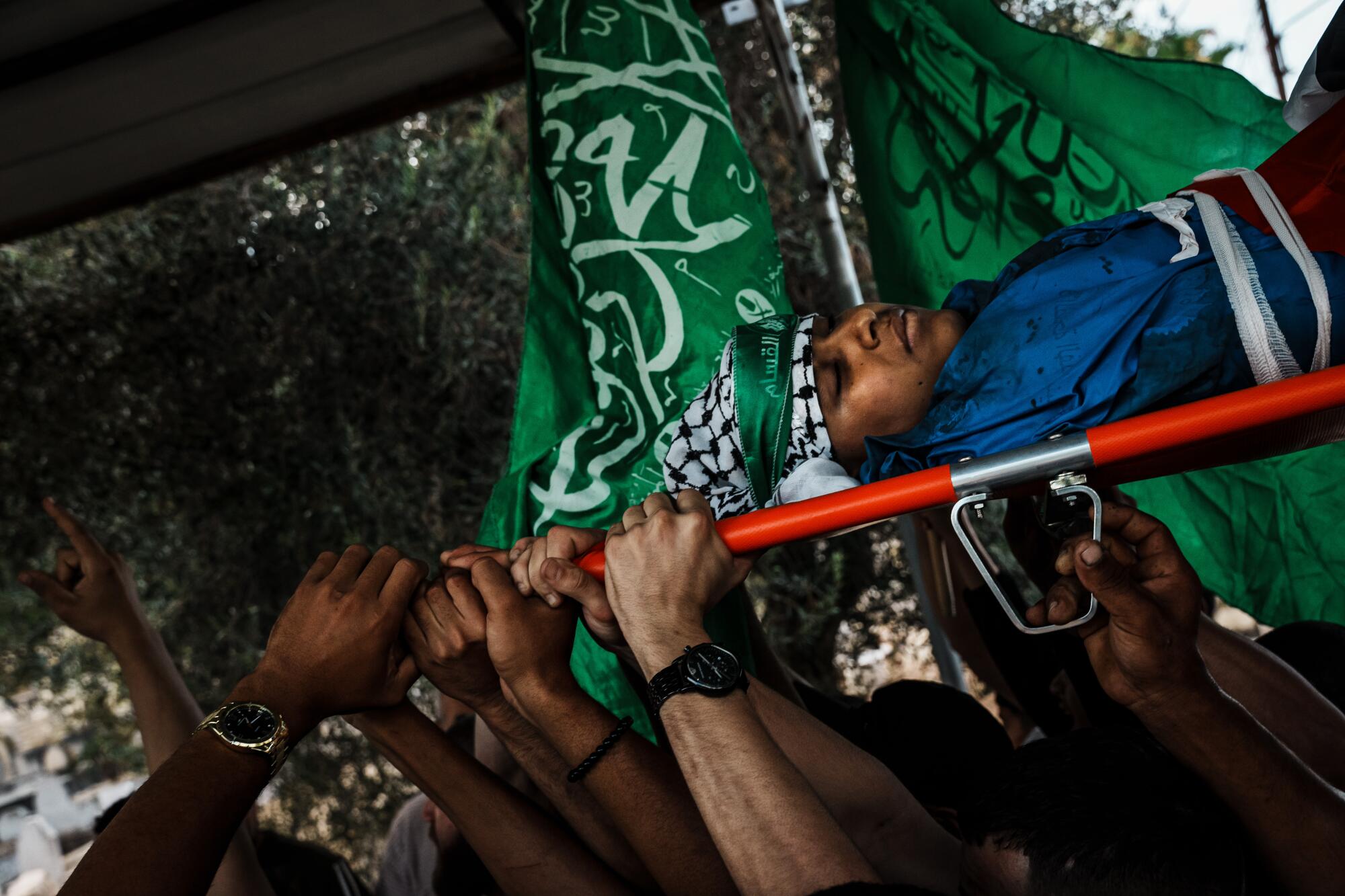
To his friends, Ali was a jokester, always a jovial presence in the street.
To his family, he was a boy who died with a rock in his hand as Israel’s armored vehicles passed through his village.
For the Palestinian politicians and fighters assembled that day for the funeral, Ali was a symbol of Palestinian national unity and an example for others to follow as violence surges in the West Bank.
“Oh martyr to you we swear, from your goals we will not stray,” the men carrying his body chanted.
The funeral ended quietly. The crowds faded away, and with them the shooting, the shouting, the speeches. A handful of Ali’s friends remained with his older brother, 20-year-old Mohammad Khazneh, who sat by the grave, his eyes red as he laid his hand on the cornerstone and stayed frozen in place. The rest were still too, stuck in a wordless eulogy.
His death was another in the worst surge of violence to have swept the West Bank in some 15 years. In the weeks since Oct. 7, when the Palestinian militant group Hamas killed more than 1,400 Israelis, Israel has focused on Gaza, where it is widely expected to launch a ground invasion.
But it has also pursued a wide-scale campaign to root out militants across the West Bank. Palestinians accuse Israel of using the Gaza-based Hamas attack as a casus belli to remove more of their people and expand settlers’ presence in the West Bank, where more than 2.7 million Palestinians live under an Israeli military occupation that began in 1967.
Israel-Hamas war: In Israel, a quest to identify unrecognizable bodies. In Gaza, bodies are piled and some stored in ice cream trucks as power fails.
They point to some 1,400 arrests (the Israeli army puts the number in the hundreds) and more than 100 Palestinians in the West Bank who have been killed in Israel’s dragnet or in increasingly frequent attacks by Jewish settlers — an average of five Palestinians killed per day, rights groups contend, more than five times the average of the last two years.
The widespread rage threatens to boil over into a full-on uprising, one that would engulf Hamas’ rival, the Palestinian Authority, which maintains limited administrative control over the West Bank and coordinates with Israel on security matters — an increasingly untenable policy as critics skewer the authority as little more than Israel’s bodyguard.
As the Jewish Sabbath fell and Muslims marked their principal prayer day, Israelis and Palestinians struggled with the terrifying new reality after the militant group Hamas’ deadly attack on Israel.
“Before Oct. 7, they would enter and walk around, and if they saw us it would usually be OK,” one of Ali’s friends, 14-year-old Abdul Fattah Issa, said of Israeli soldiers. “Now, they see anything, they shoot. Young, old, it doesn’t matter.”
Ali was shot as the Israeli military drove through the Tulkarem suburb of Danabah last week en route to an operation in nearby Nour Shams refugee camp.
Thirteen Palestinians — five of them under 18 — were killed in or near Nour Shams, according to local authorities, in what Israel said was a counter-terrorism operation that also claimed the life of an Israeli officer. The Israeli military counted 12 Palestinians dead. It said it had no record of killing Ali.
The teen was a constant presence on the streets in Danabah, where in his spare time he barbecued and sold kebab, his friends said.
“He was always there, always smiling,” said Walid Mjally, 14.
“Ali was the silliest guy in the neighborhood, a clown, teasing people,” said Salim Sarsak, a 20-year-old prosthetics specialist and friend of Mohammad Khazneh who knew Ali for all the boy’s life, saw the brothers’ older-younger dynamic.
Israel-Hamas war: In a national vigil of sorts, Israelis hope for the return of more than 220 people seized by militants and believed held in Gaza.
“I told Mohammad, ‘He always used to take your clothes,’ ” Sarsak said. “ ‘Now he’s taken your grave.’ ”
“It was a big shock for Mohammad when he was martyred.”
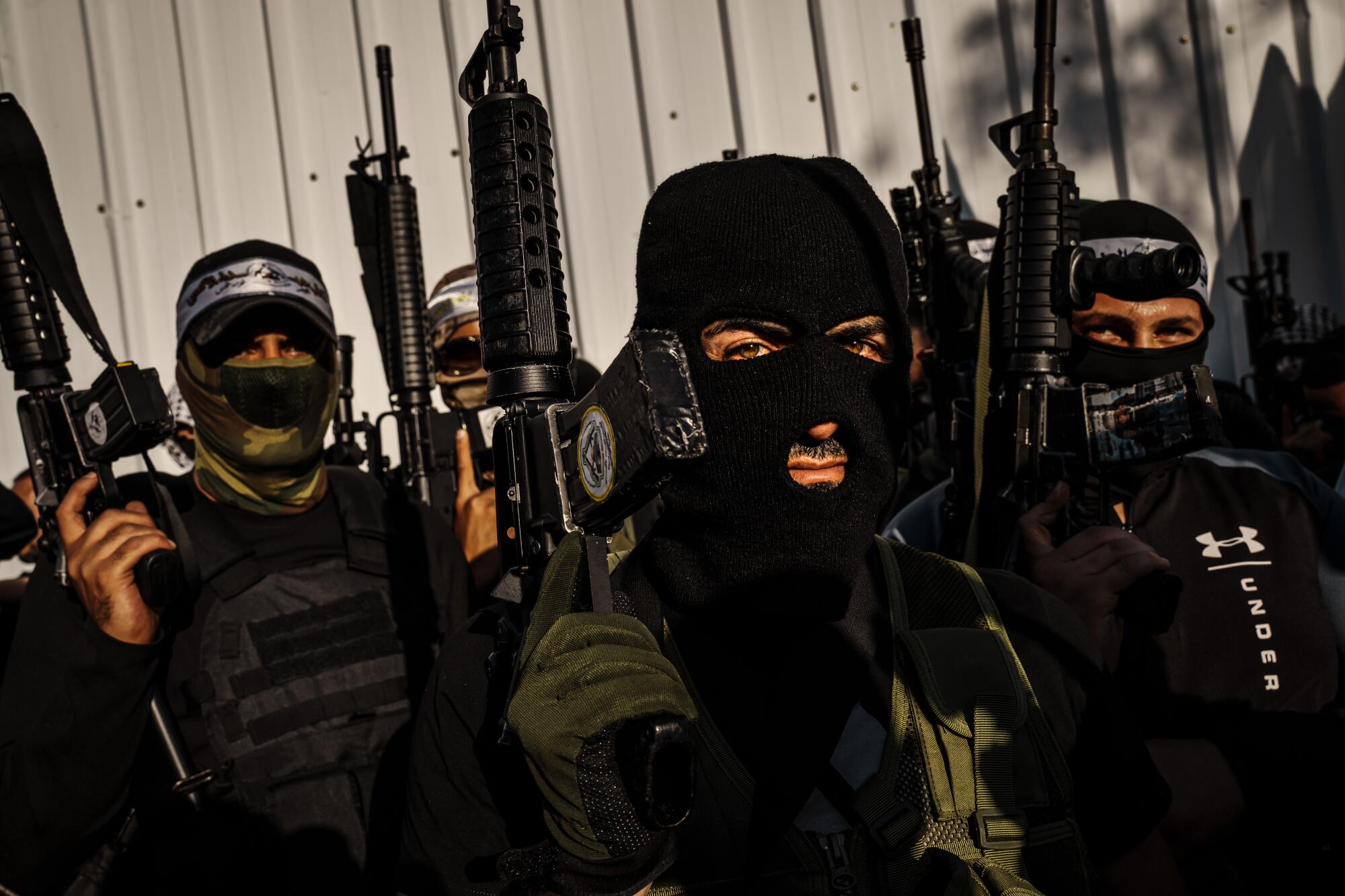
Though he was a nationalist and expected he would be killed working against the occupation, Ali was no militant, his friends and family say, despite the posters extolling his prowess as a “hero” and a “mujahed.” Instead, his killing was on the periphery of the Israeli military’s 27-hour assault on Nour Shams.
Hundreds of Palestinian Americans are reportedly stranded in Gaza, frantically searching for ways to flee before Israel’s expected ground assault.
The nearby refugee camp had been on lockdown since late Wednesday night, when border police and soldiers entered to “arrest suspects and eliminate terrorist infrastructure,” according to an Israeli military statement. Israeli forces arrested dozens, destroyed explosive-manufacturing facilities and discovered dozens of improvised explosive devices, the Israeli military statement said. It said 10 Israeli police officers were injured Thursday when a militant hurled an IED at them and that one subsequently died.
What happened later that day, like so much in the Israel-Palestinian conflict, is a source of dispute. The Israeli military said one of its aircraft detected and struck “an armed terrorist cell” gathered in one of the camp’s upper streets. Press reports have said it was a drone attack. Video released by the Israeli military on Twitter purports to show militants walking down the street with assault rifles; another clip shows one of them shooting, before the video cuts again to the moment when the strike hits.
Residents give a different version of the attack: When they heard a drone, those living on the street, named Manshiyah, quickly hid. But the drone did not fire and disappeared, so residents thought it safe to come out again, they said. Then, four residents insisted, an Apache helicopter appeared overhead and dropped a missile. It drilled some four feet into the asphalt before detonating, killing 10 people, including an 11-year-old and three 15-year-olds, Palestinian health authorities said.
Later that day, sometime before 4 p.m., two Israeli armored vehicles were driving through Danabah. Ali, as usual, was in the street, even though most people were indoors because of the Nour Shams incursion.
Khazneh went to bring his brother home, but Ali refused to go. Instead, he walked to the corner near Danabah cemetery and was standing among the trees as the vehicles passed. Rights groups say a group of young Palestinians was throwing stones at the armored vehicles, but it’s unclear if Ali was part of that group. According to his family, he was holding a stone when a soldier inside one of the vehicles shot through a gun port, hitting Ali twice in the chest.
“It was a rock. What could it do to an armored vehicle?” said Dalia, Ali’s older sister. “What’s a rock in front of bullets?”
“A rock, held by a 15-year-old kid, not even old enough to have an ID.”

Grainy video circulated on Tulkarem-based news channels on Telegram, a messaging app, depicts what residents say was the moment Ali was shot. Two vehicles pass by a figure, then one of them stops. A figure near the top of the frame then seems to crumple to the ground. The authenticity of the images could not be independently verified.
On Israel’s border with Lebanon, residents are worried that groups like Hezbollah will join a war that eventually spirals into a regionwide conflict.
At Ali’s funeral, Faisal Salameh, an activist leader in Tulkarem, saw the killings as part of a wider Israeli escalation; the strike was an especially rare step, one that harked back to times of heightened violence in the conflict’s long history.
“This was a child that they shot,” he said, shaking his head with anger. “And in Nour Shams it was an airstrike.”
“What’s happening here is a mini version of the war in Gaza.”
Ali, it would appear, was not counted. In response to questions about his death, the Israeli military told The Times in a statement: “The incident was not known to us.”
In a public statement, the military said it had “neutralized at least 12 terrorists” during the Nour Shams operation. But residents living nearby insisted there were no militants present when the missile fell and that those killed were civilians.
California native Hersh Goldberg-Polin, 23, hasn’t been seen by family since before Hamas’ attack on Israel. They’re determined to find him and bring him home.
“All the fighters left an hour before,” said Ahmad abu Talal, 38, who sat talking with some friends in the street down from where the missile had struck. “That’s why all those kids and people were out.”
“What a useless army,” Abu Talal said, his 1-year-old son, Abdullah, on his knee. “Our fighters pushed them out of the camp, so the Israelis brought a warplane. Imagine what will happen to them when they enter Gaza; they’ll be pulverized.”
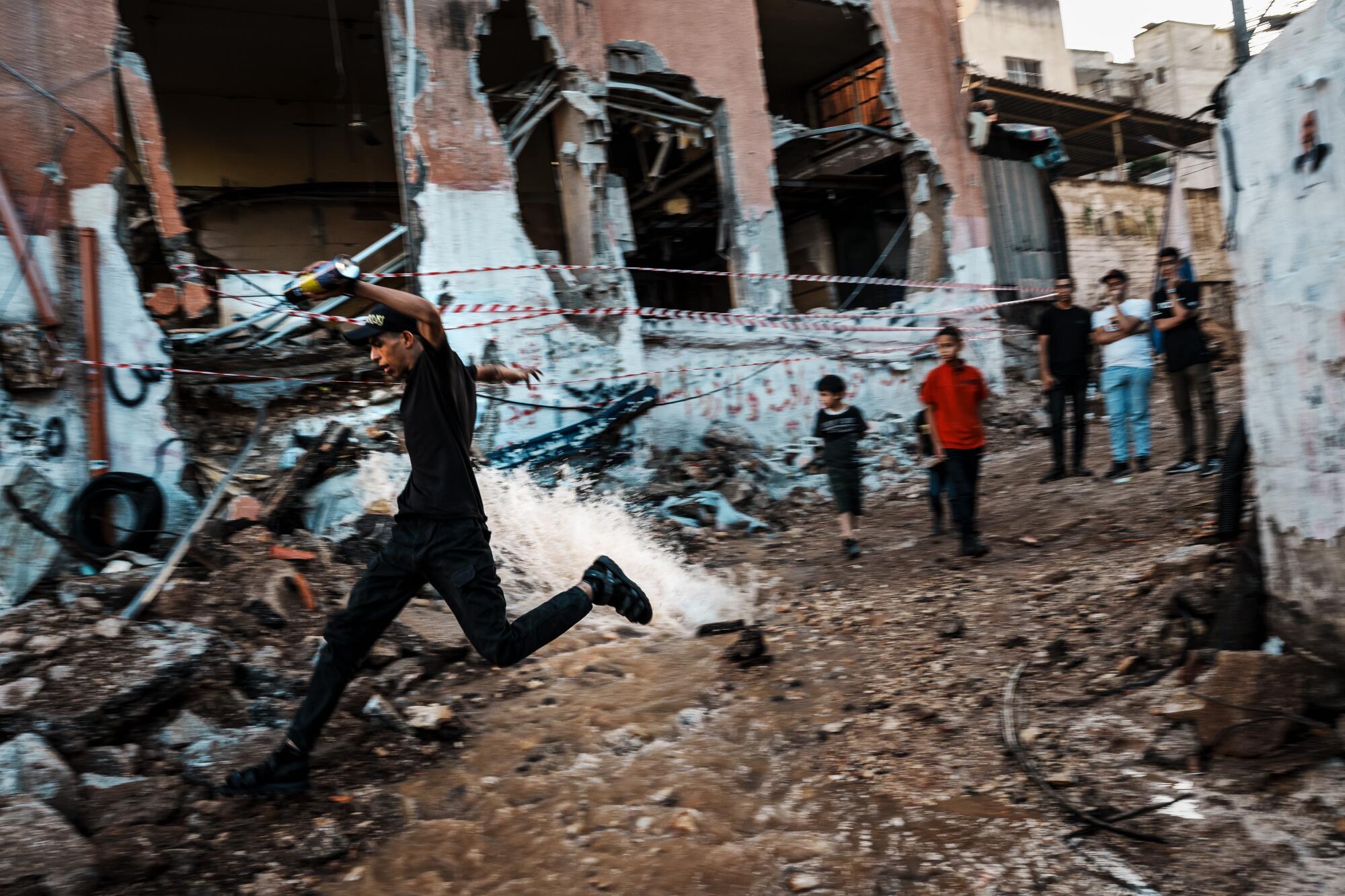
At the camp, one building, described by the Israeli military as “a command and control center,” has a side sheared off, the road in front of it churned up into a mass of sand and gravel by an Israeli bulldozer. On Manshiyah Street, passersby pause to look at a pair of burned cars marked with spiral-shaped permutations of gray, or to peer inside the narrow, cylindrical crater left by the missile. One person used a broom handle to measure its depth.
Abeer Saaydeh sat in an oval of chairs in the middle of a narrow street, surrounded by neighborhood women, holding a wake for her 15-year-old son, Mujahed, who was among those killed in the explosion.
“The people they killed, they weren’t fighters,” she said. “They didn’t have guns or weapons. My son was just standing there.”
Israeli forces wanted revenge after losing one of their own when they entered the camp, she contended. She said it wasn’t the first time the army had attacked Nour Shams.
“Now it’s intensified,” she said, adding that the camp’s water and electricity had also been cut off.
“Look at where I have to hold the wake. I’m doing it outside because our home has no power.”
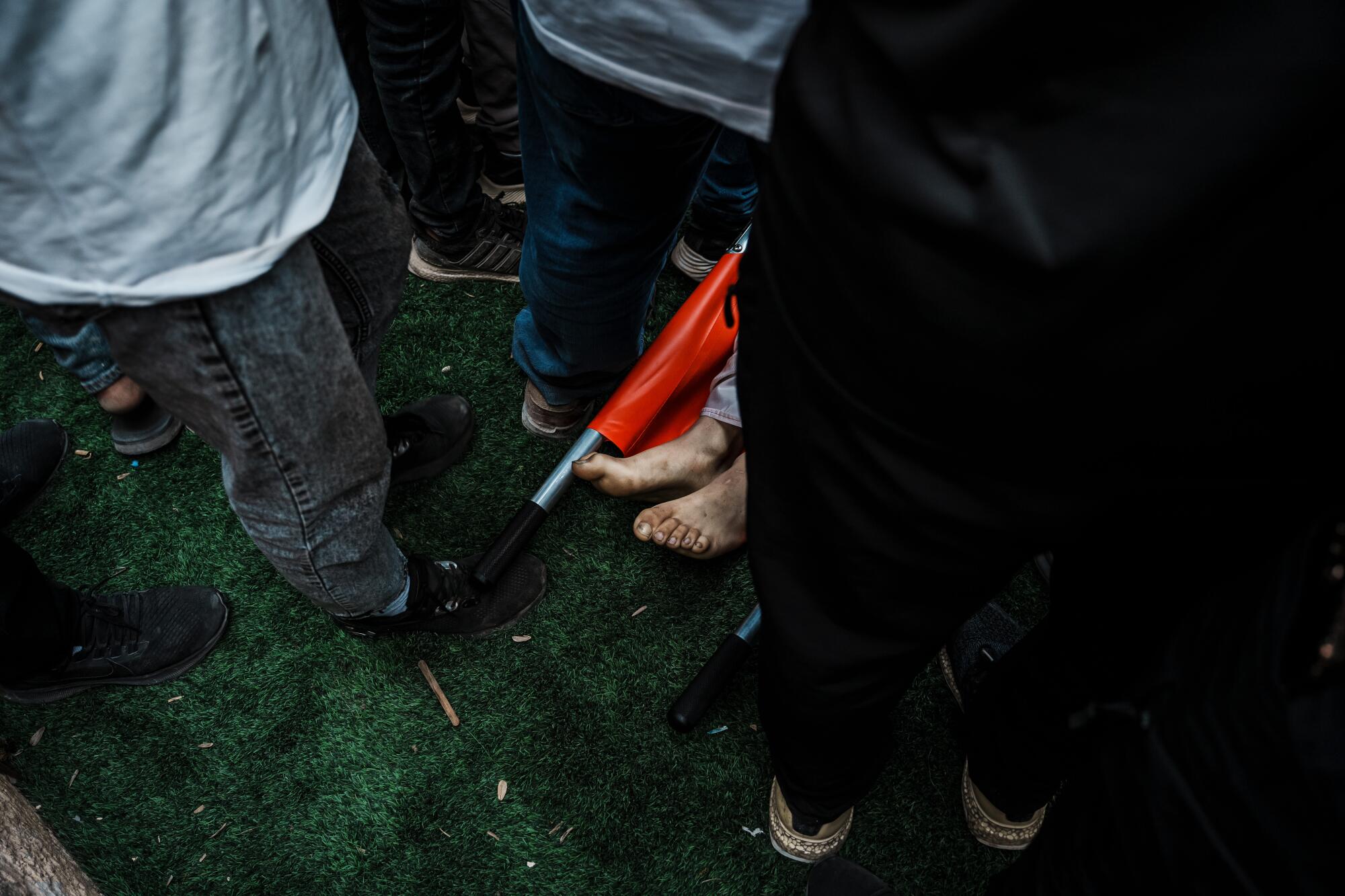
During their raid, Israeli forces demolished part of a building they said belonged to a Hamas militant who had killed Israelis in the past. Within the remains of another demolished home was a martyr photo for Iyad Kanooh, a fighter with the Fatah-linked Al Aqsa Martyrs Brigade who was killed in a shootout with Israeli forces around early 2005. He glowers at the camera, clean-shaven face superimposed near a cutout of the Dome of the Rock shrine in Jerusalem’s Old City.
The increased violence in the West Bank has alarmed human rights groups and the United Nations, which has warned of a “rapidly deteriorating human rights situation” and an increase in “arbitrary arrests of Palestinians.”
The U.N. said some people had been “prevented from reaching hospitals to receive life-saving care.” Residents in Nour Shams said a number of the raid’s victims were put in a mosque because the military prevented ambulances from reaching them.
In a statement late last week, the U.N. said, “We are extremely alarmed by the rapidly deteriorating human rights situation in the occupied West Bank and the increase in unlawful use of lethal force.”
Hamas’ attack on Israel has highlighted the differences among the foreign policy instincts — and experience — of the leading Democratic candidates for U.S. Senate in California.
The Israeli actions are re-energizing Palestinians’ fury as they watch what happens in Gaza.
“They want to kill the resistance here, so they can do what they want with Gaza,” said Rahaf, Mujahed’s sister.
The sense of a coming showdown pervaded the speeches at Ali’s funeral, with calls for setting aside any internal divisions — including the animosity between Gaza-based Hamas and the Fatah party-run Palestinian Authority.
“We today are in the cemetery of the martyrs,” Salameh said in his address. “Here hundreds of martyrs hear our voices ... we came today to give our support to Gaza, to Nour Shams, to Palestine and Jerusalem.”
Around him were fighters arrayed in the yellow, green and white bands of the various factions, including Hamas, Fatah and Islamic Jihad.
Back near Ali’s grave, in the Danabah cemetery not far from where he was killed, his friends seemed resigned to the idea they too could be killed.
“The Israelis want us to hide at home, but we won’t do that,” said 14-year-old Abdul Rahman Najjar.
Khazneh stirred, and loaded a religious recitation on his smartphone before laying it on the grave.
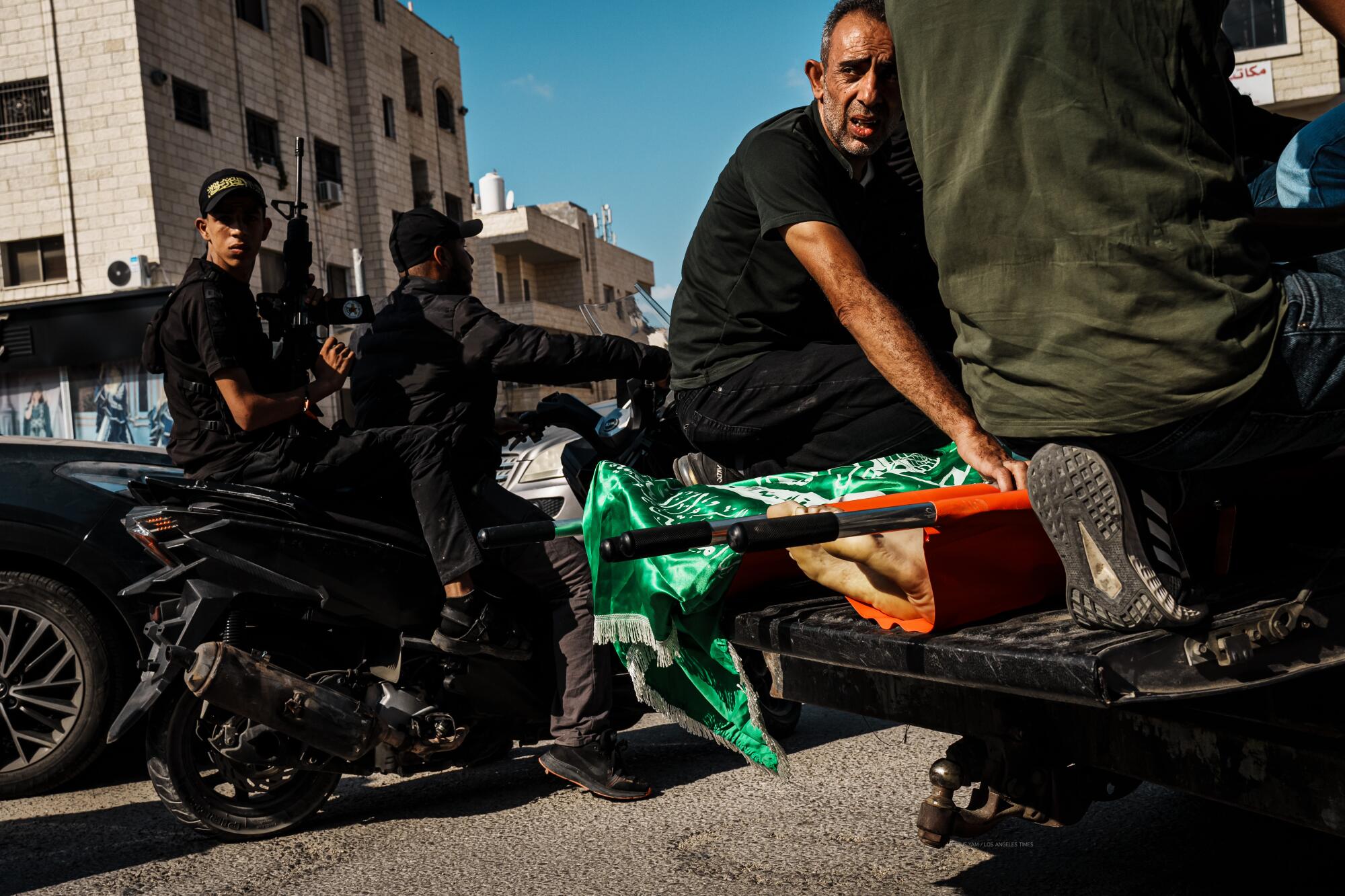
“The eyes shed tears and the heart grieves, and we are saddened by your departure, and we only say what pleases our Lord,” the recitation said.
“We belong to Allah and to Him we shall return.”
A minute later, Khazneh started to get up. Sarsak and others rushed to help him, wrapping their arms around him as they trudged away from the grave.
Standing by Najjar, Walid Mjally, 15, a burly kid with a pompadour of black hair, turned to a visiting reporter and joined the conversation.
“If we’re shot, we’re martyred. It’s our sacrifice for our homeland,” he said.
“When that happens, you’ll interview my friends and ask them about me.”
More to Read
Sign up for Essential California
The most important California stories and recommendations in your inbox every morning.
You may occasionally receive promotional content from the Los Angeles Times.

